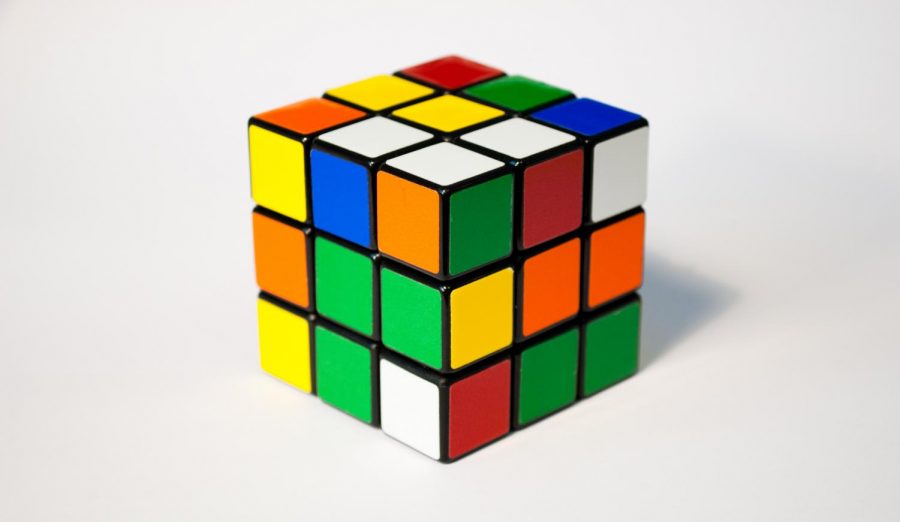I tried solving a Rubik’s cube in one week — and failed
Photo courtesy Wikimedia Commons.
I tried solving a Rubik’s cube in one week, but it was harder than it looks.
March 26, 2020
When my brother was in middle school, he loved solving Rubik’s Cubes — he’d spend hours on the computer watching videos about how to manipulate the colorful squares. At his fastest, he could complete one in under a minute.
Sometimes, when I was bored, I’d try my hand, but thirteen-year-old me never had the attention span to work on it for more than a couple of minutes. There were too many steps, and anytime my brother tried teaching me, I got frustrated and gave up.
A few weeks ago, though, I remembered my past failures and had the urge, once again, to solve a Rubik’s cube.
I searched my house to see if I could find my brother’s old cube, but I had no such luck — I was going to have to buy a new one. I went on Amazon and looked through dozens of cubes, finally settling on the perfect one: the D-FantiX Moyu Aolong V2 3×3 Speed Cube. (And yes, it did cost $15 — but if I was going to buy a Rubik’s cube, it might as well be of high quality.)
My adventures began with a control test. I would start by trying to solve a Rubik’s cube without looking online. So, I sat at my desk, set my timer and went to work.
After a painfully long attempt, I finally gave up. I looked up at the timer expecting to see a time in the one to two-hour range. I checked the time: eight minutes and 22 seconds — not bad, but I’d only solved one side of the cube. With one side of the cube complete, I took a shot at the second side; this time with less success— I was completely stuck. To say I was disappointed would be an understatement — I felt defeated and frustrated. Realizing I had no idea where to go from there, I decided that I was going to need some help.
Research & Backgrounding
I figured the first step toward solving a Rubik’s Cube was to try and understand the basics of the cube. I did some quick research on the Rubik’s Cube itself and found that a standard 3×3 Rubik’s Cube has 43 quintillion possible permutations.
This information freaked me out — how was I going to learn to solve a Rubik’s cube with a seemingly infinite number of combinations?
The answer: Rubik’s Cube algorithms. To solve Rubik’s Cubes, cubers use algorithms, which are specific operations that reorient the cube’s pieces in a certain way, making the process of solving a cube significantly faster.
I sat down and talked with senior Rony Stephan, who at his fastest could solve a Rubik’s cube in 35 seconds. Stephan told me that without using an algorithm, it would be nearly impossible for me to complete a cube; however, once I memorized the algorithms, I could learn pretty quickly. According to Stephan, the key to getting good was to practice whenever I had the chance.
Now, I just had to set a goal for myself. Stephan thought that given my time constraint of one week and my inexperience with Rubik’s Cubes, solving a Rubik’s cube in under 5 minutes was a reasonable goal. I felt like 15 minutes seemed more plausible, so I compromised and settled on 10 minutes.
Solving
First, I scoured Youtube in search of a Rubik’s cube tutorial. There were hundreds of videos, all following the same general concept: solve one step, master it, and move on to the next. I settled on a six-part video, hoping that I’d be able to master about one step a day.
The first step, the white cross — forming a cross pattern using the white face — didn’t take me long to figure out. It was definitely tricky at first, but after practicing it a couple of times, I could get it pretty quickly. Energized from my success, I felt confident I was well on my way to solving the cube.
But the further I got along, the steps grew harder, and I kept getting stuck and messing up. It was almost impossible to backtrack, so every time I made a mistake, I had to completely start over.
My struggles were valid — as you get further along in the solving process, mistakes become harder to correct, Rubik’s cube fanatic Aiden Williams, a freshman, said.
Williams lives and breathes Rubik’s cubes; he owns 12 cubes and practices about five hours a day. Sensing I was approaching a roadblock, I decided to turn to him for advice.
Aiden told me that a big part of solving Rubik’s cubes is memorization. He admitted that at a certain point in the solving process, he begins relying almost entirely on muscle memory. The only way to solve a cube quickly is to have each move completely burned into your memory.
Determined to improve, I started taking my Rubik’s cube with me everywhere I went. I figured the only way to improve my muscle memory was to practice as much as possible, so I started practicing everywhere. I even started practicing in school, taking my cube out whenever I had a spare minute, ignoring the confused looks from my classmates in favor of completing my mission.
Conclusion
By the end of the week, I realized I wasn’t going to make my goal of 10 minutes — in fact, I wasn’t going to be able to solve the cube at all. It was just too difficult, and I was too impatient.
At first, I felt disappointed. I’d put in so much time and effort, but I’d failed. Sure, I’d made some progress, but there’s nothing really cool about being able to solve half a Rubik’s cube.
As I sulked in defeat, I wondered where in the process I went wrong. Everyone I’d talked to seemed so confident that I’d be able to do it — was I really that incompetent? But it’s not just me — solving a Rubik’s cube is actually really hard.
According to mathematicians, solving a cube is considered NP complete. In simple terms, this means Rubik’s cubes are extremely difficult to solve mathematically. It even took Erno Rubik, the inventor of the cube, a month to solve his own cube.
This mix of mathematical difficulty and perceived simplicity is what makes the Rubik’s cube so interesting. While solving a Rubik’s cube requires a lot of practice and memorization, it’s also a skill that anyone with an abundance — and I mean, like a ton — of dedication and practice can pick up. Unlike most math puzzles, anyone can solve a Rubik’s cube, regardless of math knowledge or age, in fact; there are kids as young as three years old who can solve them. When solving a Rubik’s cube, most people are completely unaware of how intricate it actually is because it just feels like playing a game. It just takes a lot of time, patience, and practice.
Even though I didn’t solve the cube in under ten minutes, solving a Rubik’s cube still seems like a goal that’s in reach. I know that if I’m willing to put in enough effort, I’ll eventually be able to solve one — even if I’m no 35-second solver.








Levi • Dec 24, 2021 at 4:34 pm
I used a method taught by Arthur T Benjamin in The Great Courses plus (now called Wonderium) he claimed I would be able to solve the cube consistently in under 3 minutes with an algorithm taught him by a record holder. It took me about 2 hours over the course of two days to learn and it works like a charm. I haven’t timed myself yet but it doesn’t take me longer than 5 minutes tops
Aishanya • Dec 7, 2021 at 3:05 am
Nice , I would prefer to practice more and eventually you can easily be like sub 20
Carl • Nov 25, 2021 at 3:37 am
I learned how to solve the puzzle myself over the past month. I didn’t place a time restraint on myself, and the number of steps was daunting to begin with, but I can solve one with relative ease now. A written how to article with step by step instructions was my first crutch to lean on. I ran through the steps a few times just to test them out. After that I would try to solve as much as I could from memory and consult the How-To when I got stuck. Eventually, when you can remember all the sequences unaided it feels like you earned a fun little ‘Eureka!’ moment. I highly recommend the experience for people that enjoy puzzles!
Shahryar • Sep 25, 2021 at 3:45 am
Bruh I learned it in 2 days and took me a week to get sub 50 and for the record im not saying that im smart cause I also taught 3 of my friends how to solve and thy all were pros in under a week I even taught a 9 yr girl how to solve it and she got it on 5 days.
Vinay Kumar • Sep 20, 2021 at 7:22 am
I can teach you how to solve runic cube
Dominik Seaton • May 5, 2021 at 6:57 pm
I’m 13, and this came on my recommended, a week after I learned how to solve it, so now I realize I’m not the only one that struggled. A week ago, I was able to solve one in roughly 5-10 minutes. But as I write this, I can solve one in under a minute, and so can my friend Andrew. I have a speed cube which makes it much easier.
How to cube • May 4, 2021 at 11:36 am
Oof,watch some youtube videos on the c FOP method I find it easier than roux and zz.btw my PB is 10.98
Chris • Apr 25, 2021 at 1:53 am
I found my old cube in storage, gave it a go to search tutorials on youtube, Clickbait title, Learn To Solve Rubiks Cube In 10 Minutes! I was able to solve a cube under 5 minutes after about 20 minutes of the tutorial. I then train and practice somewhat often, I purchased a high quality GAN cube for $60 and eventually averaged 45 seconds to solve, I now am starting a collection of every type of cube from 1×1 to 5×5, pyraminx, and gear puzzle. If you put in the effort, you will learn.
AKM • Mar 13, 2021 at 1:27 am
I learnt it in 3 days now I can solve the cube within 2 mins
Jont • Feb 23, 2021 at 3:57 pm
Perhaps you could reconsider your choice of method. The white-cross approach, while super fast and monstrously efficient, has (at the outset) a terrifying number of algorithms to learn (although not all are compulsory)..
There are other techniques like Beginner’s Method which is the slowest but conceptually easiest to wrap your head around. Also try the simplistic Corners-First Method which the first world record holder used in the early 80s is a frequent first method beginners try and like. My own favorite is called Roux,which features a low move count, fewer algorithms, and also used by some elite competitors. You might find that the cube is not so much solved, as it is built up, and there are many ways of correctly putting it together. Cheers.
Alvin • Feb 15, 2021 at 12:10 pm
I watch a 10 minute youtube video. Complete the cube in 30 minutes. 1 day later I can solve it in around 4 to 5 minutes with the beginner method. It’s not really that hard, you just have to pay attention to where things move.
Stephen • Feb 9, 2021 at 6:04 am
Patients is definitely key. I took 5 days to learn it and 2 weeks to commit it to muscle memory, I can do it in 48seconds, tho I just have a standard cube so friction restricts me going faster.
Amilia • Jan 27, 2021 at 3:03 am
I tried learning when I was in school and could also only complete half. About 7 years later I saw one in a stationary shop with cute pastel colours and decided I’m going to try and learn again. Anyway, took me about only 2 hours and I could do it. Don’t know how it got so much easier for me but its like I could understand the steps better this time around.
Farooq • Jan 22, 2021 at 12:51 am
In start i used to get frustrated when solving rubic cube even if i was copying the tutorial on you tube. But one the day i decided i should really do it when i saw 9 years old boy can do it in 70 seconds. Then i watched a tutorial and it took me an hour to solve the rubic cube and now i have remembered all the algorithms and can do without watching any tutorial. I am so happy. By the way i am 39 years old man.
Mark Connolly • Jan 1, 2021 at 10:06 am
I managed to solve the cube within 4 hours by following tutorials and now I can do it 3 days later under 5 minutes lol I’m not super intelligent either, it’s just committing patterns to memory, nothing extremely difficult at all 😛